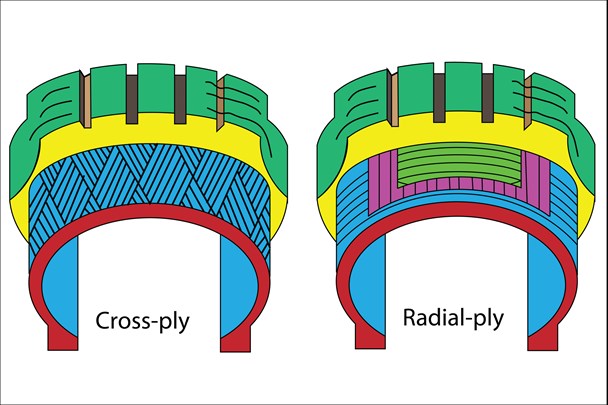Cross-ply vs Radial Tyres
This week we are looking at the two main types of tyre that can be fitted to a car, how they came about and what the key differences are between them both.
The first pneumatic tyre was produced and patented by the now famous Mr Dunlop in 1888, as a way of cushioning the wheels on his son’s tricycle. From a children’s toy to an adult bicycle, the leap was an obvious one and within a decade, Dunlop’s design had become the global standard – with his patented method of construction, known in the UK as cross-ply becoming the accepted norm for all tyres from bicycles to trucks as horses were phased out and the petrol age began.
Cross-ply Tyres
The name cross-ply refers to the way in which the tyre is constructed using a network of interlocking cords which are layered across each other at a 45 degree angle, before being encased in the toughened rubber outer shell. This web of overlapping cords is rigid and highly inflexible, which gives the tyre sidewall a huge amount of strength to withstand impacts. This strength is key, as cross ply construction is reliant on an inflated inner tube to support the tyre on the rim. As these inner tubes are made of soft rubber, if they become punctured, a flat tyre is the inevitable result, so a hard sidewall is ideal.
Radial Tyres
Invented in France by Michelin in 1948, the radial tyre was a development of the cross-ply design that was able to hold pressurised air within itself through new and more robust methods of construction. By running steel cords at a far wider angle of 90 degrees, and with the addition of steel belts to support the tread area of a tyre, the radial design was able to do away with inner tubes, simplifying production and giving additional benefits of improved ride and handling.
Without the need for a hard sidewall, a radial tyre is able to absorb vibrations and shocks far better than a cross ply can. With less cording suspended within the rubber, considerably less heat and noise is generated, which not only gives an immediate increase in comfort for the passengers of a vehicle, but it also gives a vast decrease in “blow-out punctures” due to overheating.

Which tyre is right for my car?
The first car to be produced with a radial tyre fitted as standard was the 1948 Citroen 2CV. Although this revolutionary design gave immediate benefits in handling, safety and economy, it took a few years to become the industry standard. Seen as a performance upgrade for many, it did not become a standard fitment in Europe until the mid 1960s, and in the USA until 1970.
The simple answer is that, if your vehicle was produced before 1948, then it should wear a cross ply tyre in order to be period-correct, and if made before 1970 and not a sportscar, it was also likely to wear a cross ply from new. The hard sidewalls of the earlier tyre design makes them likely to follow ridges in a road surface, known as tramlining, and they are also able to produce less traction in corners. Whilst some drivers like the delicacy of steering that a cross ply gives, it is widely acknowledged that for road use, radial tyres have a clear safety advantage.
For this reason alone, it is now common place for many classic car owners to fit radial type tyres to their cars regardless, as this is no longer seen as being detrimental to a vehicle’s originality. So long as you do not mix tyre types on the same car, there is no reason not to fit radial tyres to your post-war classic car if you wish.
Let us know if you have fitted radial tyres to your classic, and if so what you think of the difference in the comments below.
I've been reading articles on "radial Vs cross-ply" and this one is the best at explaining the whies & wherefores of how it all happened... Your article is nice and short so it's easy to read the whole thing. If I was trying to explain this to someone, I'd start by linking them here <3
abc123, 04/08/2023
Not exactly what the article is about but, amongst the few guys with sidecars on their bikes, it's not uncommon to see car tyres (on suitable rims) being used. Usually radial tyres will be fitted as they're generally easier to find for the 15" wheels used. The original 2CV size tyre is ideal. The reason is obvious; the curved tread of a normal motorcycle tyre wears very quickly. Avon do make a special tyre for sidecar bikes but it's a 19" tyre and very narrow. Seems to fit things like Austin 7's though.
IAM biker, 03/06/2021

I recently changed my 2.5 litre Riley from cross-ply to radial tyres. The car sits much better on the road and is more pleasant to drive as the radials don't pick up grooves in the road as cross-ply tyres do.
AL, 13/03/2023